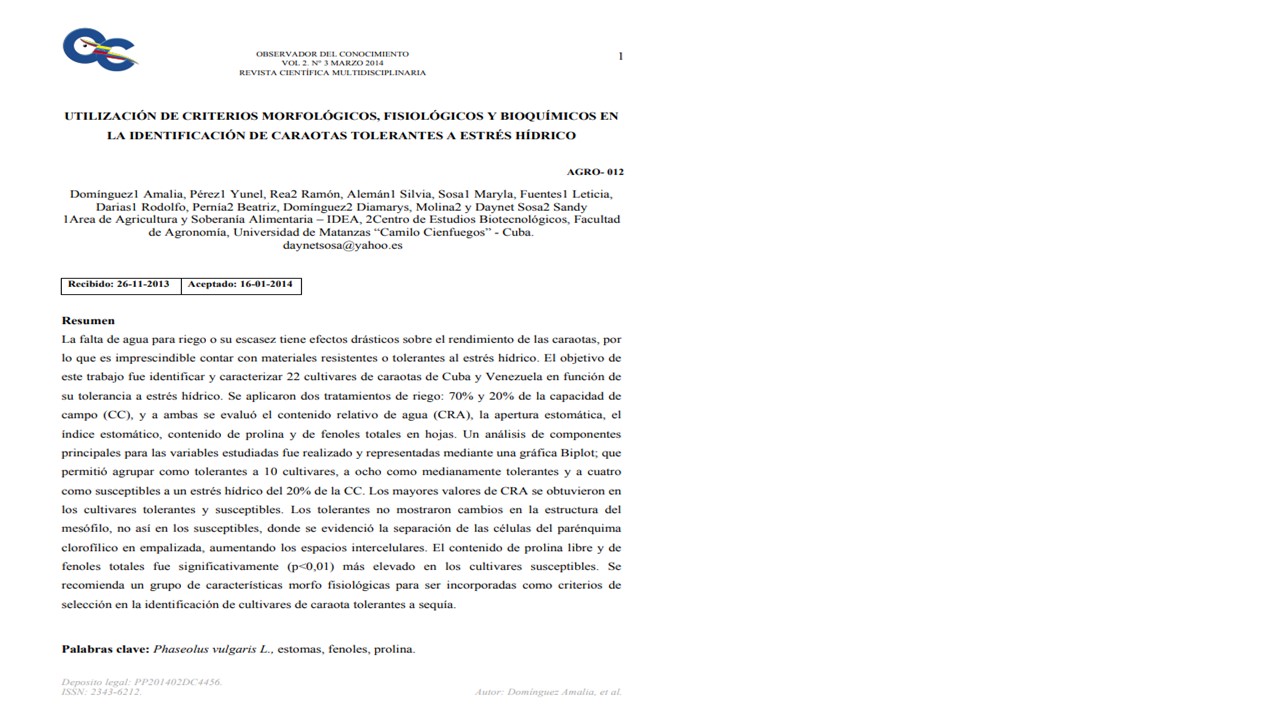Utilización de Criterios Morfológicos, Fisiológicos y Bioquímicos en la Identificación de Caraotas Tolerantes a Estrés Hídrico
Palabras clave:
Phaseolus vulgaris L., estomas, fenoles, prolinaResumen
La falta de agua para riego o su escasez tiene efectos drásticos sobre el rendimiento de las caraotas, por lo que es imprescindible contar con materiales resistentes o tolerantes al estrés hídrico. El objetivo de este trabajo fue identificar y caracterizar 22 cultivares de caraotas de Cuba y Venezuela en función de su tolerancia a estrés hídrico. Se aplicaron dos tratamientos de riego: 70% y 20% de la capacidad de campo (CC), y a ambas se evaluó el contenido relativo de agua (CRA), la apertura estomática, el índice estomático, contenido de prolina y de fenoles totales en hojas.
Descargas
Citas
Alemán, S.; Domínguez, A.; Domínguez, D.; Fuentes, L.; Pérez, Y.; Pernía, B.; Sosa, D.; Sosa, M.; Infante, D. (2010). Estudio anatómico y bioquímico en materiales cubanos y venezolanos de Phaseolus vulgaris L. bajo condiciones de estrés hídrico. RET. 1(1): 89-99.
Ascón, J.; Taylor, M. (2000). Fundamentos de fisiología vegetal. Mc Graw - Hill/
Interamericana de España. Primera Edición. ISBN: 84 - 486 - 0258-7. Cap 2. p18.
Bates, L. S.; Waldren, R. P.; Teare, I. D. (1973). Rapid determination of free proline for water-stress studies. Short communication. Plant and Soil. 39: 205- 207.
Beebe, S.;. Rao, I.M ; Cajiao, C.; Grajales, M. (2008). Selection for drought resistance in common bean also improves yield in phosphorus limited and favorable environments. Crop Science. 48: 582-592.
Bray, E.A. (2001). Plant response to water deficit Stress. In Encyclopedia of life sciences. Nature Publishing Group, [en línea], de www.els.net.
Broughton, W.J.; Hernandez, G.; Blair, M.; Beebe, S. ; Gepts, P.; Vanderleyden, J. (2003). Bean (Phaseolus spp.)-model food legumes. Plant Soil. 252:55–128.
Cornic, G.; Briantais, J.M. (1991). Partitioning of photosynthesis electron flow between CO2 and O2 reduction in a C3 leaf (Phaseolus vulgaris L.) at different CO2 concentrations and during drought stress. Planta 183: 178-184.
Di Rienzo, J.A.; Casanoves, F.; Balzarini, M.G.; Gonzalez, L.; Tablada, M.; Robledo, C.W. InfoStat version (2010). Grupo InfoStat, FCA. Universidad Nacional de Córdoba, Argentina.
Gurr, S.I.; Mc Pherson, M.I.;Bowles, D.J. (1992). Lignin and associated phenolic acids in cell walls. Molecular Plant Pathology and Practical Approach. 3: 62-69.
Hoagland, R.E. (1990). Alternaria cassiae alters phenylpropanoid metabolism in Sicklepod (Casia obstusifolia). Phytopath. 130:177–187.
Jolliffe, I. T. (2002). Principal Component Analysis, Series: Springer Series in Statistics. 2nd ed. ISBN: 978- 0-387-95442-4. 487 pp.
Lizana, C.; Wentworth, M.; Martinez, J.P; Villegas, D.; Meneses, R; Murchie, E.H.; Pastenes, C.; Lerzri, B.; Vernieri, P.; Horton, P.; Pinto, M. (2006). Differential adaptation of two varieties of common bean to abiotic stress. I. Effects of drought on yield and photosynthesis. J. Exp. Bot. 57: 685–697.
Muñoz-Perea, C.G.; Terán, H; Allen, R.G. ; Wright, J.L; Westermann, D.T.; Singh, S.P. (2006). Selection for drought resistance in dry bean landraces and cultivars. Crop Sci. 46: 2111–2120.
Rao, I. M. (2001). Role of physiology in improving crop adaptation to abiotic stresses in the tropics: The case of common bean and tropical forages. In Pessarakli, M. (ed.) Handbook of Plant and Crop Physiology. Marcel Dekker, Inc., New York, USA. 583-613.
Wilkinson, H. (1979). The plant surface (mainly leaf) In: Anatomy of dicotyledons (Metcalfe, C.R. & L. Chalk, eds.). Second edition. Vol. 1. Oxford Claredon Press. London.
Rodés, R.; Collazo, M. (2006). Manual de Prácticas de Fotosíntesis.1era ed. Universidad Autónoma de México ISBN: 970-32-3313-9.
Thung, M.; Rao, I. (1999). Integrated management of abiotic stresses. En: Singh, S. (ed.) Common bean improvement in the twenty-first century. Kluwer Academic Publ., Dordrecht, The Netherlands. 331- 370.
Yordanov, I.; Velikova, V.; Tsonev, T. (2003). Plant responses to drought and stress tolerance. Bulg. J. Plant Physiol. 187-206.

Descargas
Publicado
Cómo citar
Número
Sección
Licencia

Esta obra está bajo una licencia internacional Creative Commons Atribución-SinDerivadas 4.0.







